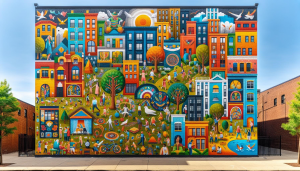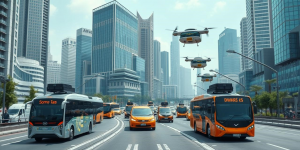Let’s be honest, urban sprawl is a monster. We’ve all seen it: endless cookie-cutter houses, soul-crushing commutes, and the feeling that you need a car just to grab a gallon of milk. But what if there was a better way? What if we could design neighborhoods where life was less about fighting traffic and more about connecting with people?
That’s where Transit-Oriented Development (TOD) comes in. For years, I’ve watched cities evolve, witnessing the impact of thoughtful urban design. TOD is about creating lively, walkable areas built around excellent public transport. It’s about building communities, not just concrete.
What Exactly Is Transit-Oriented Development?
Simply put, TOD means creating dense, mixed-use neighborhoods within easy walking distance of a major transit hub. Think train stations, light rail stops, or bus rapid transit centers. It’s a conscious effort to blend transportation and land use, encouraging a more sustainable and enjoyable urban life.
The Core Principles of TOD
TOD isn’t just about dropping some apartments next to a train platform. It’s a comprehensive approach to city planning, guided by these key ideas:
- Density: Higher density is key to support transit and create a lively urban atmosphere. Think apartments, condos, and townhouses, not sprawling single-family homes.
- Mixed-Use Development: Blend residential, commercial, and recreational spaces within walking distance. This creates a “complete community” where you can live, work, and play without a car. Imagine grabbing coffee below your apartment, walking to work next door, and meeting friends for dinner across the street.
-
Walkability and Bikeability: Prioritize pedestrians and cyclists. Wide sidewalks, protected bike lanes, and inviting streetscapes encourage people to ditch their cars.

- Connectivity: A well-connected street layout makes it easy to get around. Avoid dead-end streets and prioritize through-streets.
- High-Quality Transit: The transit system must be frequent, reliable, and convenient to attract riders and make TOD successful.
- Reduced Parking: By offering alternative transport, TOD can cut down on parking needs, freeing up land for other uses.
- Affordable Housing: Including affordable housing ensures TOD benefits everyone, promoting social equity.
TOD in Action: Success Stories
The beauty of TOD is its adaptability. It works in bustling city centers and in suburbs seeking revitalization. Here are some inspiring examples:
- Curitiba, Brazil: Often considered a TOD pioneer, Curitiba’s bus rapid transit (BRT) system has driven growth along transit routes. Their land-use policies encourage dense development near BRT stations, creating a more sustainable and fair city.
-
Arlington, Virginia (USA): The Orange Line corridor is a prime example of TOD success. High-density residential and commercial buildings have sprung up around Metro stations, creating vibrant, walkable neighborhoods.
- Vancouver, British Columbia (Canada): Vancouver’s SkyTrain system has fueled significant TOD, particularly in Metrotown and Brentwood. These areas have transformed from low-density suburbs into thriving urban centers with housing, offices, and shops.
The Benefits of TOD
TOD offers more than just less traffic. It provides many benefits, including:
- Reduced Traffic: By offering convenient alternatives, TOD cuts traffic and improves air quality.
- Environmental Sustainability: TOD encourages sustainable transport, reducing emissions and reliance on fossil fuels.
- Economic Development: TOD attracts businesses and residents to transit-rich areas, stimulating economic growth.
- Increased Property Values: Properties near transit stations tend to be worth more than those in car-dependent areas.
- Improved Quality of Life: TOD creates walkable, livable communities with access to amenities, jobs, and transit.
- Enhanced Social Equity: TOD can provide affordable housing and improve access to jobs and services for low-income residents.
The Challenges (and How to Beat Them)
TOD isn’t always a walk in the park. Challenges can include:
- NIMBYism (“Not In My Backyard”): Resistance from residents who don’t want higher density or changes to their neighborhood. Solution: Involve the community early in the planning, address concerns, and highlight the positives of TOD.
- Funding: Getting funding for transit and TOD projects can be tough. Solution: Explore various funding options, including grants, state/local funding, and private investment.
- Zoning: Outdated zoning that favors single-family homes and car-dependent development can hinder TOD. Solution: Update zoning to allow higher density, mixed-use development, and less parking.
-
Coordination: TOD needs collaboration between transportation, planning, and housing agencies. Solution: Establish clear communication and teamwork.
The Future of TOD
As cities grow, TOD will be vital for creating sustainable and livable urban spaces. I think we’ll see even more innovative TOD approaches, like:
- Micro-mobility Integration: Adding bike-sharing, scooter-sharing, and other micro-mobility options to enhance connectivity.
- Smart City Tech: Using smart city technologies to optimize transit, manage traffic, and improve the user experience.
- Resilient Design: Designing TOD projects to withstand climate change impacts.
Ultimately, TOD is about building a future where our cities are more sustainable, equitable, and enjoyable. It’s about building communities, not just commutes. And I’m excited to be a part of it.


